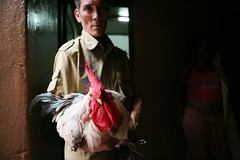
Artists borrow inspiration from life to express themselves. The worlds of arts and entertainment have often borrowed from Ifa –the religious traditions of the Yoruba, and its American cousin –Santeria. Most often found are sensationalized settings depicting images meant to inspire horror for dramatic effect. American film audiences are both thrilled and terrified by symbolism that seems frighteningly familiar and violently primitive.
It is no wonder that practitioners of these faiths meet with difficulty as they become more visible in American culture and society. Rarely depicted are core spiritual principles which include peaceful co-existence, the personal and spiritual goals of attaining balance in life, and of taking personal responsibility for one’s circumstances and actions. It is true that ritual sacrifices, ecstatic trances, spirit possessions, and ancient divinatory practices are all very alive within Ifa and Santeria. However, understanding the religion more deeply adds layers of symbolic meaning to which Hollywood images and depictions merely hint, but our instinctual minds respond.

Modern practitioners, those who come to Ifa and Santeria without previous heritage and familial ties, have many social taboos and indictments to overcome. Often, they find it difficult to study the sacred teachings or find spiritual mentorship. Even so, the number of initiates in this age of science and skepticism is on the rise.
By tradition Ifa and Santeria have been historically secretive in sharing their ways and practices. This is born out of a need to protect initiates from persecution by other religions –most notably Christianity. The majority of practitioners come from “word of mouth” Oral traditions, where teachings are passed down within a family or casa de santos (house of saints), also known as an ilé. Those coming from outside cultures seeking to learn the ways and practices of Ifa and Santeria often meet with mistrust and hostility, as they seek out information and attempt to interact with seasoned initiates.
Neophytes most often run into trouble when their understanding of the practices come with little or no practical example, or trust worthy guidance. Those coming from outside the tradition often lack the cultural background and experiences which would otherwise assist them in deriving deeper meaning and reverence for the ways and practices. This lack of understanding does create fissures between new initiates and those who have grown up in the faith. However, it is no surprise that cultures dominated by Christianity find the religious practices of Ifa and Santeria difficult to understand let alone accept. Christianity left behind ritual blood sacrifices, with all the cultural and symbolic implications, when it embraced the idea of a “final sacrificial savior,” and created the symbolic enactment of the Eucharist. The ensuing passage of time has alienated many Christians from their ritual past and from other cultures and faiths that retain blood rites and practices. The deeper symbolism and meanings associated with ritual animal sacrifice are easy to dismiss, or reject as horrendous, when there is no personal context associated with shedding blood. The entertainment world takes advantage of these cultural rifts when choosing images, and depicting distorted, or even honest scenes of ritualized animal sacrifice, ecstatic frenzies, spirit possession, and other practices.

Industrialization of the food industry has further estranged modern societies from the bloody business of slaughter. Gone are the days when killing and plucking a rooster for Sunday dinner was an American family norm. Modern American's, especially those removed from rural life, are often repulsed and confused when slaughter occurs as part of religious practices. People from cultures where industrialized farming and Agribusiness are the way of life, often have difficulty conceiving of or witnessing any form of slaughter. In cultures where the slaughter and butcher of meats in the home remains prevalent, people have very little difficulty accepting ritual sacrifices as part of religion. "We feed ourselves and we feed the Gods." For these people ritual sacrifice is often part of everyday life. These are the kinds of cultures where Ifa, and Santeria are well established and visible.
Whether the entertainment industry has benefited these religions through increased exposure, or harmed them through negative depiction, is a matter of debate. What is certainly true. . . the worlds of arts and entertainment will continue to derive inspiration from them, religious scholars will investigate and share their findings, and dedicated initiates will continue to practice.
For information on the ritual practices of Santeria, refer to Sacrificial Ceremonies of Santería: A Complete Guide to the Rituals and Practices
, authored by Ócha'ni Lele , published by Destiny Books.
Come back and read our review Friday, 9/5/2014.
No comments:
Post a Comment